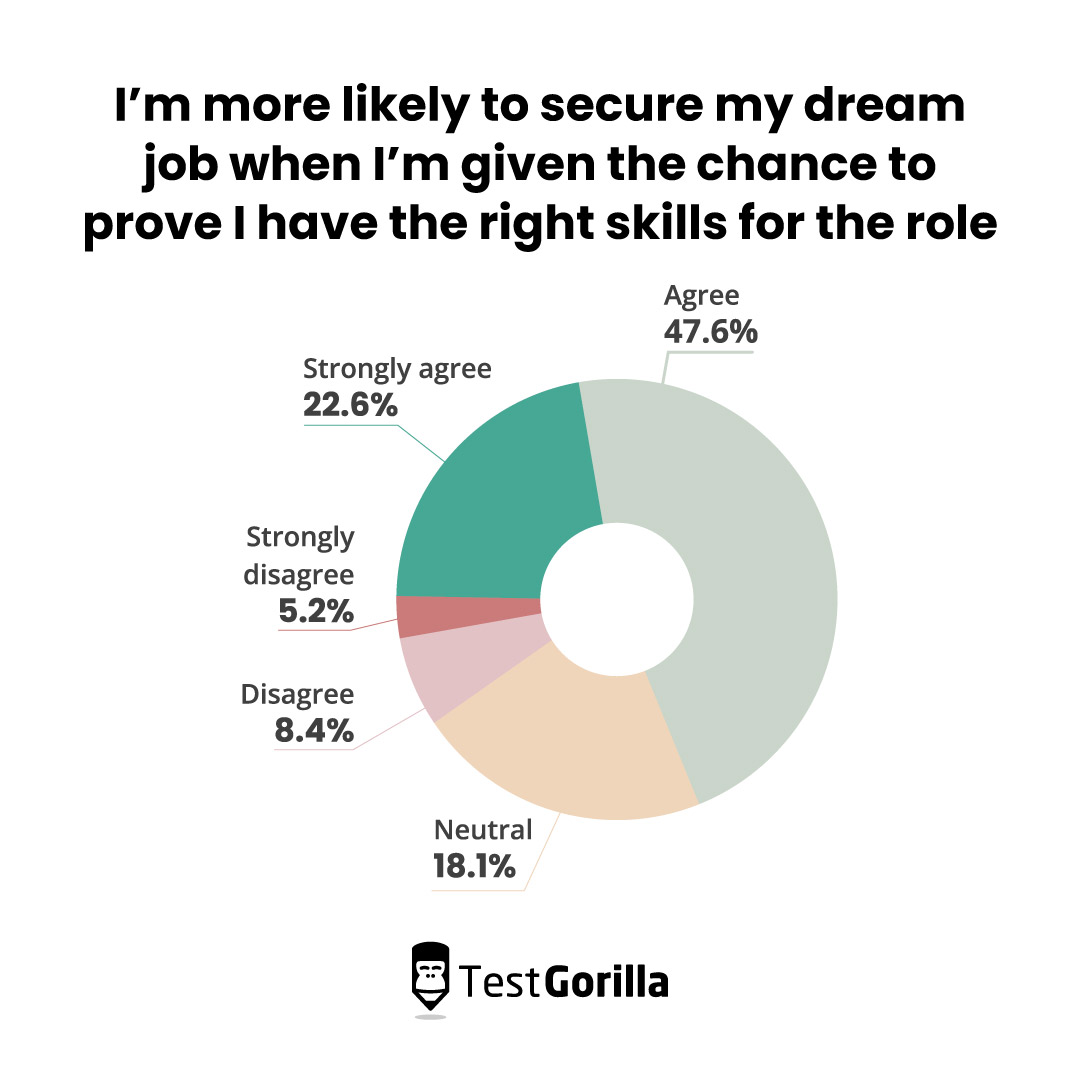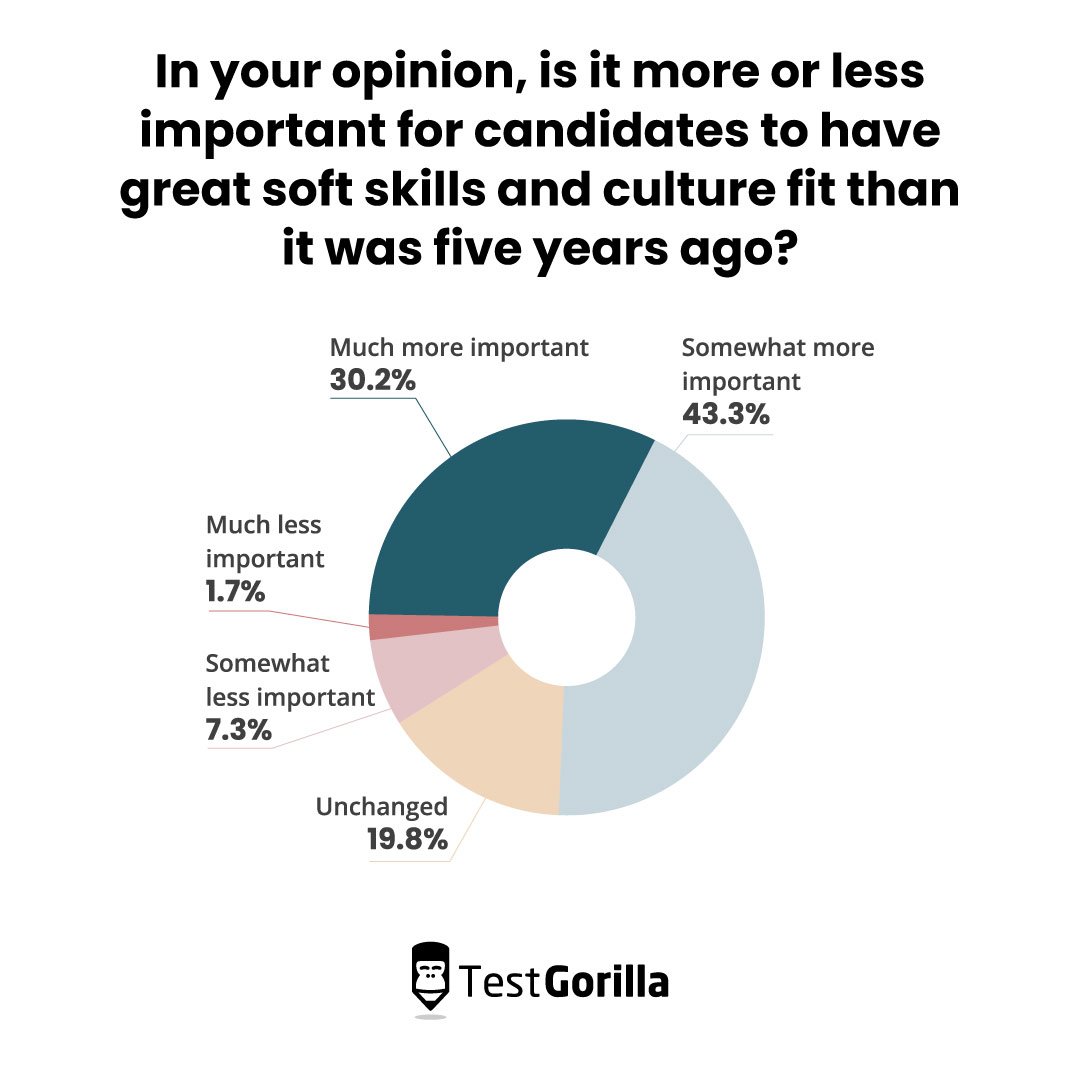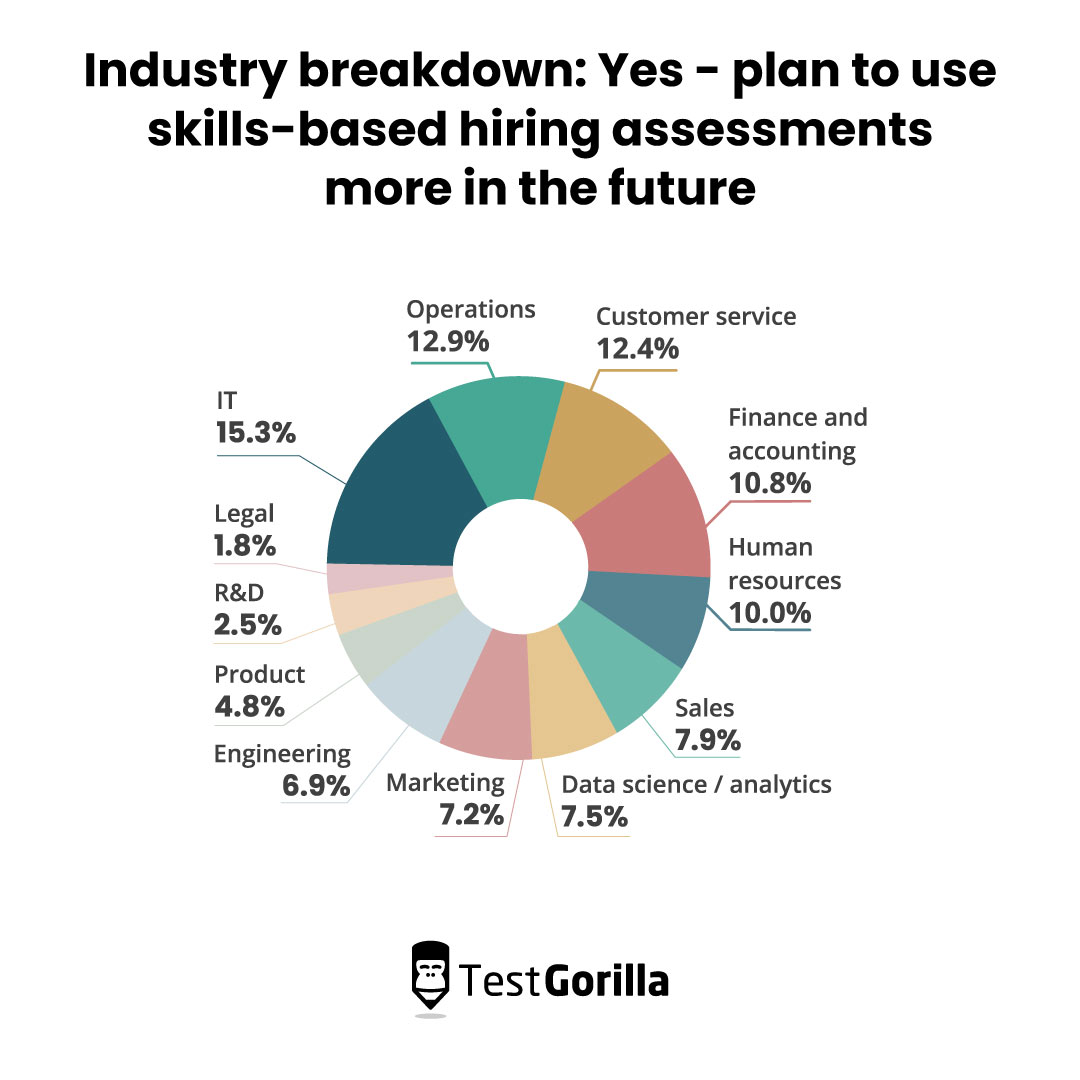Since the Covid-19 pandemic and the Great Resignation, when employees quit their jobs en masse, the labor market has been candidate-led. Employees are looking to move to jobs that allow them more flexibility and opportunities for advancement. And employers must be savvier than ever to secure valuable global talent.
Faced with larger candidate pools and growing pressure to make the right hire the first time, companies are turning to skills-based hiring. They are recognising that resumes are limited, that they’re prone to exaggerations, and can increase bias in decision-making.
By contrast, skills-based hiring practices allow you to create a fairer, more precise hiring process and to find better fits for your roles. But some organizations are being held back from achieving the full impact of skills-based hiring because of certain key challenges. These are:
The difficulty of adding an extra stage to the hiring process
Questions around the reliability of tests
The high volume of applications
Budget considerations
In this article, we’ll explore the reasons for these challenges and how you can mitigate them and implement skills-based hiring in your organization. We’ll also look at trends in the space and share data from our report The State of Skills-Based Hiring 2023.
By the time you’ve finished reading this post, you’ll understand how to use skills-based hiring to improve employee engagement, reduce time-to-hire, and cut hiring costs.
Table of contents
Challenges and solutions with skills-based hiring
Business leaders sometimes worry that the challenges of implementing a skills-based hiring approach will hamper recruitment efforts. But when companies take the necessary steps to properly execute skills-based hiring, it’s possible to avoid complications and create a more efficient hiring process.
In our 2022 State of Skills-Based Hiring survey, we asked employers about the four challenges they face when adopting skills-based hiring. Let’s look at each challenge in turn along with ways to overcome them.
1. Adding a stage to the process
Adopting a skills-based approach involves an extra step between receiving a candidate’s application and inviting them to interview.
38.2% of hiring managers in our survey say they’re concerned that adding this extra step will slow down the recruitment process and mean missing out on top talent.
While candidates who drop out at the evaluation stage of the recruitment process do so because they feel that employers are disrespecting their time.
However, any effective talent assessment strategy needs to be centered around what employees want. And our report shows that skills-based hiring is that the majority of talent prefers skills-based hiring.
Of the respondents surveyed, 70.2% agreed or strongly agreed that skills-based hiring practices increased the likelihood that they could secure their “dream jobs.” A further 55% said that it enabled them to access career opportunities that would otherwise have been out of their reach.
The answer to this challenge lies in not seeing skills-based hiring as an additional step in the traditional recruitment funnel, but rather a replacement for time-consuming resume-based screening.
Our data shows that candidates are willing to undergo extra steps if they improve fairness and their chances of securing a role.Source: The State of Skills-Based Hiring 2022
2. Reliability of results
61% of employers say they’ve settled for a candidate that did not exactly match their job role. For organizations that take great care to avoid this, skills-based hiring practices can seem daunting. In our survey, 32.7% said they still doubted the quality and integrity of skills-based assessments.
By using tests designed by subject-matter experts in areas like coding or branding strategy, you can rigorously check candidates have the skills they claim on their resume.
For each job role, you can organize and optimize an assessment based on a range of tests and ask custom questions for insights into candidates’ personalities. This ensures you’re creating a recruitment process with the quality, integrity, and validity necessary to get the right shortlist of candidates.
Tests that take a scientific and multi-layered approach begin with a psychometric framework based on well-established principles of test theory. Subject-matter experts in each field then develop the questions for each test. The tests are peer-reviewed by other experts to ensure their accuracy and effectiveness. And finally, statistical algorithms analyze key indicators to verify and improve them.
When you use skill’s based tests, you’ll be able to cut down on valuable time by asking candidates skills and knowledge questions during interviews, as only those with the right profile will make it this far.
Those who use online recruiting methods like skills-based hiring find that they’re more easily able to hire the right candidate every time. Over 34% of employers we spoke to stated that skills tests helped them predict how well job applicants would perform in their prospective roles.
What’s more, by preventing candidates from cheating during the application process, you get a more accurate insight into how they will perform in a role. For example, our own anti-cheating measures include copy-and-paste blocks to stop people from copying the questions into a separate document, time limits to prevent people searching for answers, and webcam screenshots to verify identity.
3. Volume of applications
For the average role, hiring managers may need to assess between 10 and 100 profiles. From assessing tests to processing results, evaluating large numbers of applicants can be difficult with a more intensive, skills-based hiring process.
As Paul Musters, CEO of Emaho, says “One of the reasons skills-based hiring helps is because you don’t have to overthink how to make a hiring decision because you have a framework in place. It saves you time and, even more importantly, it saves you headspace.”
When considering that many resumes companies receive are from candidates who don’t meet the skills requirements, the problem becomes even more acute. Sorting through these to decide which candidates to send tests to is far too much admin.
Applying standardized testing lets you automate the process. This helps you cut the time and, therefore, costs associated with sifting through applications. Having sent a link to candidates for them to fill in the assessment at early stages, hiring managers can see their real-time results ranked in order in one dashboard.
4. Budget considerations
28% of employers that we surveyed said that they would have trouble implementing skills-based hiring due to a lack of budget. And in situations where team members have to prepare tests themselves, this certainly makes sense. Given that the overall cost for finding a new recruit when using traditional hiring methods can be three or four times their salary, making the process more expensive isn’t an option for most companies.
Automated skills-based hiring solutions allow you to set up customizable, multi-measure tests for a range of skills quickly. This cuts the costs associated with skills-based hiring processes as well as the hidden costs of recruitment.
Here’s how:
Sixty percent of the total expenditure for filling an open position is incurred by placing departmental leads and senior managers in supporting roles across the hiring process. With an automated test, these team members can take a step back, which reduces the associated costs.
Eighty percent of people note difficulties in screening applicants using resume tools. Automated skills-based hiring means only the most suitable candidates are invited to an interview. You’ll also save your staff time and cut costs by avoiding labor-intensive resume management systems.
By being able to move quickly on hiring, you avoid the costs of losing great candidates and improve return on investment. Sourcing the right candidates also boosts the productivity and performance of your team and business, as well as reducing costly mis-hires.
What does successful skills-based hiring look like?
Once hiring managers overcome the perceived challenges to skills-based hiring, they can look forward to a range of business and cultural benefits for their organizations.
Greater efficiency
Employers can save time, cut recruitment costs and mis-hires, and improve employee retention when they adopt skills-based hiring. This new way to recruit allows companies to look past the inaccuracies found in resumes and letters of application.
Job applicants are assessed on quantifiable skills. This could be through tests around hard skills, such as mechanical reasoning, or soft skills like communication. You can also ask them to complete take-home assignments or submit samples of work to demonstrate their expertise.
Winning the talent war
As occupational mobility increases, focusing on who can perform best in a role rather than who has the best experience or qualifications on paper will allow companies to win the talent war by accessing a wider, more diverse candidate pool of global talent. And a more diverse workforce has many benefits, for example, improved creativity and higher employee engagement.
Overcoming bias
While resume-based screening processes can overlook candidates unfairly, for example, because of a gap in work history due to childbirth, skills-based hiring levels the playing field for diverse candidates. In part, this is because it helps you identify people who will complement and enrich your company culture, no matter what their background is.
Better soft skills
Our research also shows that in the coming years, companies will focus increasingly on soft skills and culture add rather than hard skills. And hiring managers report that skills-based hiring makes it easier to pinpoint candidates who express qualities and values that align with their company vision.
Over the past five years, more employers have begun to focus on soft skills and culture fit.Source: The State of Skills-Based Hiring 2022
Having a future-proofed hiring method
According to our report, 53.4% of people feel that skills-based hiring will become the dominant method of recruitment in the coming years. This makes sense when considering that recruiters are more likely to find a suitable candidate when they focus on skills. Qualifications and experience just don’t predict success in the same way that hard, soft, and transferable skills do.
Our report shows that companies of all sizes and across all industries recognize the importance of implementing fairer, more accurate recruitment processes. 38% of people are planning to invest more in skills-based testing in the coming years.
The industries with the highest adoption rates of skills-based testing are IT, operations, and customer service. And it is unlikely to be a coincidence that these are the areas in which advances in artificial intelligence are leading to growing automation.
Finding the best fit for a more “human-skills” based role (one that requires communication or leadership qualities, for example) is easier when utilizing soft skills assessment than when looking at a number of years of experience on a piece of paper.
IT roles are leading the way when it comes to skills-based hiring, but adoption is high across industries.Source: The State of Skills-Based Hiring 2022
Skills-based hiring: a new way to think about recruitment
Skills-based testing can transform hiring processes. By reducing bias and highlighting candidates who might otherwise be overlooked, it provides a powerful alternative to outdated and misleading resumes.
Employers are becoming aware of how it can help them to find the right people for their positions. According to our State of Skills-based Hiring report, a majority feel that skills-based hiring will become the dominant method of recruitment in the coming years.
Some companies are concerned about adding time to their hiring processes, the reliability of results, the volume of applications, and budget considerations.
But to solve these challenges, companies can:
Replace resume screening with a more efficient and effective skills-based solution
Use standardized tests and automate the assessment process
Use testing software that incorporates anti-cheating measures
With a high number of applicants applying to positions where they don’t have all of the required skills, automated solutions are critical to streamlining hiring processes and maximizing ROI on hiring costs.
By focusing your recruitment strategy around what employees want—objectivity and a fair shot at the roles they have the skills for—employers can find the right candidates and reduce the need for rehires.
Looking to reduce mis-hires and find a better fit for your roles? Nailing skills-based assessment methods saves you time and money and helps create more diverse and productive teams. Download the report to learn more.
Related posts
Hire the best candidates with TestGorilla
Create pre-employment assessments in minutes to screen candidates, save time, and hire the best talent.
Latest posts
The best advice in pre-employment testing, in your inbox.
No spam. Unsubscribe at any time.

Hire the best. No bias. No stress.
Our screening tests identify the best candidates and make your hiring decisions faster, easier, and bias-free.
Free resources
This checklist covers key features you should look for when choosing a skills testing platform
This resource will help you develop an onboarding checklist for new hires.
How to assess your candidates' attention to detail.
Learn how to get human resources certified through HRCI or SHRM.
Learn how you can improve the level of talent at your company.
Learn how CapitalT reduced hiring bias with online skills assessments.
Learn how to make the resume process more efficient and more effective.
Improve your hiring strategy with these 7 critical recruitment metrics.
Learn how Sukhi decreased time spent reviewing resumes by 83%!
Hire more efficiently with these hacks that 99% of recruiters aren't using.
Make a business case for diversity and inclusion initiatives with this data.























